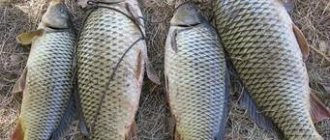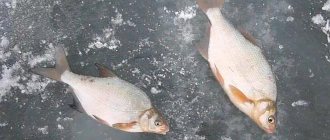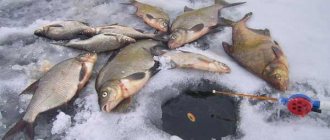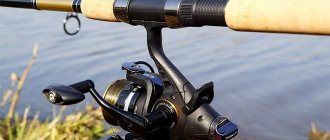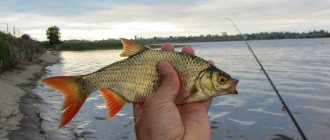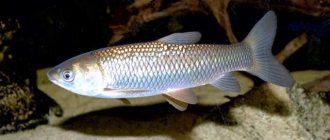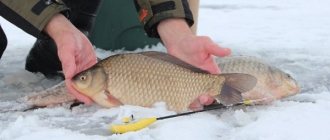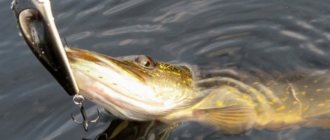How does winter carp behave?
Carp is a very large fish. Its habitat is large rivers and reservoirs; you should look for fish at deep and medium depths. He chooses snags, where there is food all year round and where he can hide from predatory fish.
When it's cold, its activity decreases, unlike some representatives of peaceful fish species. This, first of all, is the main difficulty in catching him. It makes sense to start hunting when a continuous cover of ice is established in the places where they live. In the second half of the winter, you can already start fishing.
In winter, carp is able to eat food both in the morning, afternoon and evening, as well as on separate short trips. It is difficult to predict in advance how the fish will behave, so you should expect long periods of fishing for carp in the winter from early morning until late evening.
It has been noted that the most productive fishing for carp from ice occurs when the temperature rises. When the temperature rises, fish easily take various baits.
Method of catching carp in winter
There are two main ways to catch carp in winter - with a float rod and with a nodding rod with a jig. Both options can be equally successful, but the use of a float rig remains the first choice.
Fishing with a float
The use of a float rod when fishing for carp from ice has a large number of fans due to its simple equipment and ease of fishing.
The carp’s love for running water makes its own adjustments to the installation of equipment:
• a weight is attached to the end of the fishing line, the mass of which should not allow the current to carry the tackle to the side; • above the weight, at a distance of 10-15 cm, a leash 30-35 cm long with a hook is tied; • the hook used is very strong, usually number 7 or 8 according to the domestic size chart. For animal baits it is better to take models with a long forend, for plant baits - with a short one.
The principle of operation is that the weight remains at the bottom and holds the tackle at the casting point, and the leash with the hook, caught by the current, oscillates a few centimeters above the ground.
The length of the leash can vary depending on the bite and fishing conditions, and reach 1 meter or more.
You can use any float - either store-bought or home-made, made from a piece of polystyrene foam painted in a bright color. The weight is usually 4-5 g. There are two loading options:
1) the float is located flush with the water, as when fishing in summer. This is applicable at above-zero temperatures during the thaw, when the hole does not freeze;
2) the float is located under the surface of the water at a depth of 3-5 cm. This option is suitable for fishing in the cold, the main thing is to clear the hole of ice in time. If the mass of the main sinker is not enough, then additional weights are hung on the fishing line.
When fishing with a float, you can use a thin braided line, but if the carp is too active and the bites are too sharp, then it is better to use a monofilament.
The fishing technique is not complicated - bait is placed on the hook and the equipment is immersed in the hole until the weight touches the bottom, the float is fixed at the desired depth and the fishing rod is placed on the ice next to the hole in anticipation of a bite. A bite on a tackle with a retractable leash involves moving the float to the side.
Fishing with a jig
Catching carp in winter with a jig usually occurs at the beginning of winter, in the first 2-3 weeks after the formation of solid ice. During this period, the fish are quite active and go well on artificial baits with attached bait.
The gear is the same as when fishing with a float, the only difference is in the use of a nod as a bite signal.
The characteristics of the jigs are as follows:
• models – pellet, small pellet, larva; • the size is large, largely depends on the size of the fish; • material of manufacture – tungsten. Such jigs are the heaviest and resist the current well, on which carp are caught; • the color is light; for greater depths it is useful to have a phosphorescent coating on the bait.
Two main fishing techniques are used:
1. On a standing jig. The most common method. The jig stops about 5 centimeters above the bottom level, and the fishing rod is placed next to the hole on a stand. A bite is indicated by an upward movement of the nod.
2. Wiring. The nozzle is released into free fall and carried downstream. After reaching the bottom, they begin to carefully and smoothly pull it up with a reel.
The technique is chosen by the fisherman depending on the bite. It is better to have several jigs of different models and weights in order to select the most catchy bait during fishing.
Where to look for carp
Finding carp is not very easy even in the summer, and in the winter months it becomes a very difficult task. In order to complete it, sometimes it takes 7–14 days. Like many other fish, carp waits for spring at depth, in places where there is a lot of oxygen for it, at the same time it tries not to be where there is a significant current. Even such a powerful fish, which is distinguished by its endurance, is quite difficult to resist the flow of water during a hungry period.

In addition, fishermen noticed that it is possible to catch carp in December and other months where the carp are located. It is not yet entirely clear why he is interested in these places, but it is clear that these two species of cyprinids are related to each other.
On a well-known reservoir, where all the uneven places on the bottom have been studied for a long time, searching for the necessary place for catching carp from the ice in winter will not take much time. The situation will be different if the river or body of water is not familiar. Here it will be much more difficult to find a suitable place, especially for those who do not have many years of experience in hunting this fish.
You can find carp in winter:
- in holes, at great depths;
- at the boundaries of current and “quiet” water;
- at the bends of rivers, where, due to the flow of water, there are depressions and various food appears there;
- at overgrown or snagged depths that are far from the shore line.
In other places, carp can appear only sporadically, so there is no point in drilling holes blindly.
Winter fishing for carp. Video
This article is devoted to such a rather interesting topic: winter fishing for carp. A caught carp is a source of special pride for the fisherman who managed to pull this bronze trophy out of the river depths. Since fishing time is winter, you need to dress appropriately for fishing.
Moncler down jackets are the best solution. Moncler is a global brand that produces clothing for an active lifestyle, sports, and for urban fashionistas. The clothes of this brand, in particular down jackets, are light, high-quality and incredibly warm.
It is impossible to freeze in them even at very low temperatures.
It is best to catch carp in winter in clear and calm weather.
Tackle for winter fishing for carp
It is best to catch carp in winter using float gear equipped with a multiplier or inertia-free reel, which can well absorb the powerful and sharp jerks of this strong fish.
However, do not forget that spinning reels can cause a lot of inconvenience if it is too frosty outside. The preferred diameter of the fishing line for winter fishing for carp is 0.2-0.25 mm, and the thickness of the braid can range from 0.04 to 0.06 mm.
If you catch carp in winter in heavily snarled places, then it makes sense to use a thicker fishing line - up to 0.3 mm.
In a situation where you are fishing with floatless gear, the fishing line must be constantly in a taut position and connected to a sensitive bite alarm. For winter fishing for carp, hooks No. 9-12 (according to the international classification) are more suitable than others.
Carp can be caught either with a simple hook or with a spoon or jig. If the weather is relatively warm, it will be more convenient to catch carp using tackle with a small float (30-40 mm), for example, a “waggler” or a sliding float. If the weather is frosty, then it is better for the float to be in the form of a “tablet”.
It’s easier to monitor bites if the upper tip of the float is recessed by 1 cm. If there is a risk of the line freezing, then it is preferable to use a removable float, which can be quickly detached if necessary by hooking.
In winter, carp are caught with bright yellow or white floats or with black or red top floats.
What to use to catch carp in winter
As bait for catching carp in winter, it is best to use bloodworms, maggots, worms, a crust of bread, a piece of potato, pearl barley, canned corn, and green peas.
Bait from a bunch of bloodworms has one significant drawback - it is quickly taken away by small fish. Carp can also be caught with boilies in winter; it is best to use honey, tutti-frutti, and strawberry boilies.
It’s also a good idea to use complementary foods for winter fishing, which you can buy at the Crucian Carp store.
How to find a place to catch carp in winter
Very often, winter fishing for carp is not complete without a rather tedious search for places where the fish feed. Usually the carp, in search of food, explores places rich in oxygen. Carp are often caught in places where there is a school of crucian carp. A good bite of carp can be observed in warm winters, when thaws often occur.
Carp bites well throughout the winter - on the first ice, in the dead of winter, and on the last ice. It is best to catch carp in winter during the daytime, in clear and windless weather, or when the wind is in a southerly or westerly direction. If the water is less than +5 C, then carp should be caught at medium depth, away from the shores.
In particular, carp love places where a lot of water lilies and algae grow in summer.
Source: https://plotka.ru/zimnyaya-ryibalka-na-sazana-video/
Best time for winter fishing
Winter fishing for carp can take place throughout the winter period, but it is not always uniformly active. At low temperatures, warm-loving carp do not feel their best, so they hardly bite. But closer to the spring months and during long thaws, fishing can bring excellent results. Especially in the first month of spring, when the temperature is already above zero, but the ice is still strong. During this period, the carp begins to leave its favorite places and look for food, so it is advisable to rely on bait. Here you should not go to extremes; the mixture for fish should be served in small quantities, but regularly.

If you do everything correctly, you can keep the carp in one place for a week or even more. You should lure the carp quietly, without attracting attention, without saying anything to other fishermen who are nearby. In the opposite situation, the next appearance on a pond can bring disappointment. Someone can sit over the holes that have already been fed and enjoy the results.
Fishing is a lot of work, especially when it comes to fishing in winter. In addition to the fact that the temperature outside reaches 20 degrees cold, the fish still need to be found, which requires drilling dozens of holes. It’s great if the fish is found very quickly, the ice is not yet very thick and drilling holes will be easy. Therefore, many fishermen set themselves a simple task - to catch at least some fish. In most cases, the catch is perch. To catch a carp, you need to try hard.
Winter fishing for carp
Fishing in inland waters in winter has its own characteristics depending on the season and type of fish.
Carp and carp are especially valued for their excellent taste, making excellent fish soup. Carp is a freshwater fish covered with dark golden scales weighing 3-4 kg, but there are individual specimens reaching 55 kg with a lifespan of 30-35 years. This species belongs to the cyprinid family with distinctive features: 2 pairs of thick, short antennae growing on massive lips and a wide dorsal fin with a sawtooth-shaped front ray.
The carp lives in reservoirs with dense vegetation with obligatory thickets of reeds, the shoots of which are the main food for the carp and shallow currents (slow-flowing rivers, lakes with dense vegetation). In the presence of an abundant food supply (reeds), the fish quickly gains weight and reaches a commercial size and weight. Some specimens reach a length of about a meter and a weight of 35 kg.
Large specimens of fish live mainly in pits, in which they spend time between feedings. The information disseminated that in winter carp go into hibernation is not reliable. In winter, during severe frosts, carp are inactive and with the onset of thaws they begin to actively hunt.
Features of catching carp in winter
Best time
Carp is a very common species that lives in rivers and lakes in most regions of the Russian Federation. Moreover, a large number of subspecies of carp have differences in appearance and are active in winter.
Even if the water in the reservoir has a temperature of 0.2 * C, carp continue to lead an active lifestyle. Most of the time, the fish lies at the bottom of the reservoir, periodically making small movements to feed. Fish beds are usually carried out in places where there is a supply of fresh running water rich in oxygen.
The strongest specimens of fish periodically search for food, examining the bottom of the reservoir. If a river or stream does not flow into a reservoir, then carp choose bedding areas near underwater springs.
Carp are most vital and active in warm winters. The first fishing begins with the appearance of thin ice and lasts until the beginning of spring. Fishing is carried out during the daytime in clear sunny weather on calm days.
To increase fishing productivity in fishing areas, it is necessary to constantly feed fish, which contributes to the accumulation of carp. In different bodies of water, carp develop different feeding habits depending on local habitat conditions.
Best places
The best places to catch carp are:
- When rivers and streams flow into a body of water, where the water is most enriched with oxygen.
- Habitats of the food supply – “silver” crucian carp.
- Where carp accumulate at water temperatures below +5*C are medium depths with a significant distance from the shore.
- Wintering pits for carp aggregations.
Winter tackle for carp in winter
In winter, the following gear is used to catch carp:
- winter fishing rod;
- feeder;
- float rod.
Most fishermen who prefer winter fishing for carp use float gear for this, and prefer vegetable baits as bait. Fishing rods are usually equipped with multiplier or spinning reels that allow them to dampen sudden jerks of fish when biting.
As fishing line, it is better to use samples with a diameter of 0.2 - 0.45 mm (designed for carp up to 5 kg) or twisted braid 0.8 - 1.6 mm, and when fishing in reservoirs with a clogged bottom - fishing line 0.3 - 0.6 mm.
It is necessary to use No. 9 – 12 (according to the international classification) as hooks.
Depending on fishing conditions, you can use:
In calm weather or when there is a thaw, you can use a 30-40 mm float (“sliding”, “Wagner”). If the weather is frosty, then it is necessary to select a float made in the shape of a “tablet”.
To prevent the float from freezing to the fishing line, it is better to use a removable model, which can be quickly detached when fishing for fish. It is also necessary to take into account the color of the float. It is preferable to use colors: white, yellow, red, black, which attract fish.
As a fishing rod, many fishermen use a feeder, which is a rod with a top to which a bait, sinker and hooks are attached.
It is especially worth noting the technique of fishing for carp from the ice, which requires some caution and it is advisable to have a small hook for fishing fish out of the water.
It is also necessary to pay special attention to the diameter of the hole; it must be at least 150 mm (holes with a diameter of 100 and 130 mm are insufficient), which will allow you to get fish out from under the ice without any problems.
Bait
For successful fishing, you need to select the appropriate bait and bait for the fish, the fish will react most actively.
The bait should attract fish, but not allow them to get enough of it. The amount of bait should not exceed 300 g per day. You can prepare bait yourself or purchase factory-made bait from a specialized fishing store.
The following can be used as bait to attract carp in winter:
- Bloodworm.
- Breadcrumbs.
- Chopped worms.
It is mandatory to add an appetite stimulant to the bait, which attracts fish with a keen charm. Feeding the fish should last from 1 to 4 days to completely get used to the feeding place.
The following baits can be used for catching carp:
- bloodworm;
- caddisfly;
- bark beetle;
- maggot;
- canned corn;
- green peas;
- barley;
- shrimp;
- crayfish meat;
- semolina mash;
- boiled potatoes
Fishermen prepare their own dumplings for catching carp, or buy boilies.
Boilies for fishing in winter include:
- “Natural Food” mixture – 1 tablespoon (tablespoon);
- attractant “Wild Milk” - 5 ml;
- sweetener "Mega Sweetener" - 3 ml;
- chicken egg -5 pcs.;
- fish meal “Mahin Protein Mix” - 500 g;
- appetite stimulant “Appetit Stimulator Fruit” - 1 tablespoon (tablespoon);
- attractant “Tutti Frutti” - 5 ml.
First, a mixture is prepared from all the components, which is mixed well until a homogeneous mass is obtained. Roll the resulting mixture into balls with a diameter of 1.5–2.0 cm and place in boiling water for 2 minutes. and removed for cooling. Later, when fishing, balls (boilies) are used for bait when fishing for carp.
When going fishing, you need to take with you various bait and, through experimentation, select the one that most actively attracts fish.
Fishing technique
To catch carp in winter, the following gear is used: a winter fishing rod, a feeder, a float rod, as well as various baits that have their own characteristics.
With the onset of cold weather and the disappearance of plant food in reservoirs, the carp begins to hunt small fish, small fish, and crustaceans. During this period, you can use spoons, jigs and prepared plant and animal baits to catch carp.
To catch carp in winter, most fishermen purposefully use a float rod using boilies or vegetable baits.
As floats, models are used in which it is possible to adjust the load capacity by adding or removing weight, thereby ensuring the level of immersion of the float and its reaction when a fish bites.
In winter, carp actively reacts to jigs, and specimens weighing up to 5 kg are often encountered. The jig, when actively playing in the layers of water, begins to “play” and attracts fish, which attack it. In winter, “Uralka” jigs equipped with hooks No. 5-7 are used. The weight for fishing is selected depending on the strength of the current. The carp prefers running water.
It is also necessary to constantly monitor the tension of the fishing line to prevent breakage when a fish bites suddenly.
Amateur fishermen who prefer winter fishing note the need to choose a reservoir for fishing. You need certain skills and some experience to achieve a positive result. Particularly noteworthy is fishing organized in special places (bases, paid reservoirs), where fishing is regularly carried out, which makes it possible to relax and catch a decent amount of fish.
Source: https://bolshoyulov.ru/zimnyaya-rybalka-na-sazana/
Winter tackle for ice fishing for carp
Proper gear is required to catch carp in winter. You should carefully select your gear, as if you assemble the winter equipment incorrectly, this can lead to the fish leaving.
Carp practically does not look at the thickness of the fishing line, so you should not be puzzled by this issue. The diameter of the monofilament can be from 0.2 to 0.5 millimeters. Depends on how high quality it is, as well as the size of the expected carp.
You should also pay a lot of attention to the hooks. Of course, it is unlikely that anyone will catch carp with “swallows”.

A fishing rod for ice fishing for carp in winter should be elastic and rigid so that it can be sharply hooked. The size depends on the fisherman's habits and ease of use.
The coil is small, made of plastic, without steel elements; in the cold they can freeze. Today's fishermen sometimes use specialized winter multipliers. This or that option is chosen based on the fisherman’s budget, because the multiplier is an expensive thing, it also requires very careful handling. But you should understand that the simpler and more unpretentious the tackle, the better, especially when you catch carp.
Carp always take bait without any problems, so the carp’s bite in winter is visible on all gear. There is no unnecessary element in a nodding fishing rod; it is simpler and more reliable. However, the float is more familiar and convenient for many anglers, so it can often be found on a pond.
Attachment, bait and bait for carp
The bait and bait are worms, bloodworms, maggots, steamed corn, bread, and you can feed them with winter bait, which contains animal components. But a long-term bait works best, at least five days. And here the bait can be the simplest: “Salapinskaya” porridge, bread, crackers, makukha (cake slabs), steamed or canned corn. You can add fish oil, bone or fish meal to the bait. Winter flavoring syrups with fish and shrimp scents also work well. Boilies are also added to the bait. They can be cut into halves. This is cheaper, and the bait will lie better on the bottom.
To catch carp in winter, you need an ice screw with a sufficiently large hole diameter, at least not less than 150 mm. Otherwise, without a hook, you may not be able to get the fish out of the hole.
I recommend to read:
Fishing for crucian carp in winter
Share with your friends!
Baits for winter fishing
- We buy ordinary corn at the store. We put one grain on and lower it. The fish notices the bait and pounces on it;
- cook pearl barley, cool, add a teaspoon of coffee. The aroma spreads quickly;
- small shrimp. Carp loves it very much and eats it all year round. The smell attracts even hibernating carp. An expensive solution, but it is completely justified. The advantage is that the shrimp does not come off the hook;
- small pieces of fresh lard. Other species of fish of impressive size are often caught.
Nozzle for catching carp in winter
In winter, this type of fish prefers baits of animal origin (bloodworms, maggots, red worms) and plant origin (bread, potatoes, corn, pearl barley and green peas). According to the observations of fishermen, fishing with boilies is considered the most effective. They are small balls used as bait. In addition, fishing with corn, worms, semolina, cake and shrimp is popular.
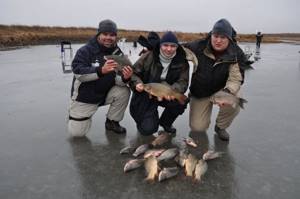
Fishing technique and tactics
The technique is not complicated:
• you can search and fish the holes one by one until the coveted carp bites, then feed the place and put out more fishing rods. Fishing rods should be moved and there should be a large distance between them; • stationary fishing is also possible. It is better to choose the place where you will fish, taking into account the relief and old holes; you can also discuss this with local fishermen.
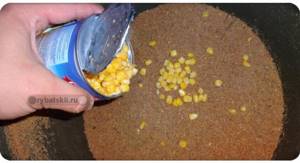
If the bait is corn, then some of it should be added to the bait. Then you should expect a bite, it is sharp and you need to hook without delay so that the carp does not drag away the tackle.
A fishing rod with a jig is used for fishing at the beginning of winter, in the first few weeks after solid ice has appeared.
Bait for fishing in winter
Carp is a very capricious fish, so when catching it, it is imperative to use bait. Feeding mixture can be purchased at the store or made independently. The following components are used for bait:
- Wheat groats;
- Corn;
- Green pea;
- Semolina;
- Cake.
The ingredients do not need to be crushed, that is, they should be heavy. Because small particles will create a cloudy column that will attract small fish such as roach or crucian carp.
